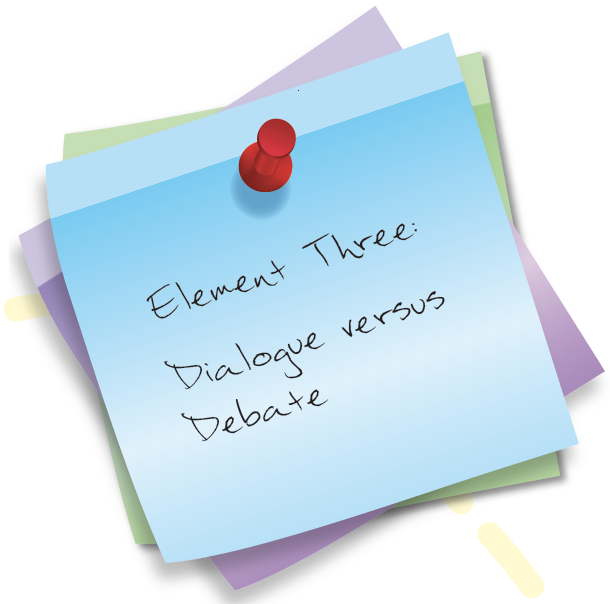
Element Three: Dialogue versus Debate
Conversation is the building block in which innovative teams operate. When decision-makers fail to invest time and resources in understanding the problem, conversations often quickly move to focusing on pre-identified solutions or become paralyzed by disagreements. Indeed, multiple projects in our research utilized design thinking after a history of previous problem-solving efforts becoming gridlocked in non-productive arguments.
Successful design-oriented conversations are most vividly illustrated perhaps by what they are not. They don’t accept obvious and conventional problem definitions, allow extensive debates, or concentrate primarily on evaluating options visible from the start. Instead, they first explore the problem definition itself as a hypothesis, seek to understand rather than to argue with others’ differing perspectives in an inquiry-focused conversation, and look for solutions to emerge during the process. This approach supports innovation processes by encouraging a focus on surfacing tacit assumptions, fostering team alignment and learning, allowing for emergent solutions, and building engagement and trust.
Without a disciplined dialogue, the diversity of perspective critical to creative thinking can become a double-edged sword as diverse teams often experience greater conflict. Without a structured methodology guiding inquiry, discussions frequently devolve into debate, with advocates of competing ideas arguing their perspectives and doing little listening. Simple design thinking methods—like turn-taking and the use of Post-It notes to individually write down ideas before sharing—ensure that all voices are able to contribute. Design thinking’s robust, but managed, dialogue is needed when the environment is uncertain, stakeholders are not aligned, and learning together becomes imperative. For collaborative creativity, knowledge is created through social interaction.
Dialogue impacts innovation processes by inviting team members to make tacit assumptions and beliefs visible, allowing the team to surface diverse perspectives in an environment focused on understanding, rather than defending them. This, in turn, allows diverse groups to explore the logics underlying their different views and fosters alignment and learning collaboratively, building engagement and trust.
Critically important, these discussions allow new solutions to arise during the conversation. Systems theorists who study complex adaptive social systems refer to the criticality of emergence in which the most interesting and creative ideas are rarely visible at the beginning of any innovation process but, rather, develop from conversations during it.10 A key
strategic impact of design thinking, therefore, is facilitating emergence.
Learn about Element Four: Iterative and Experimental Process.




